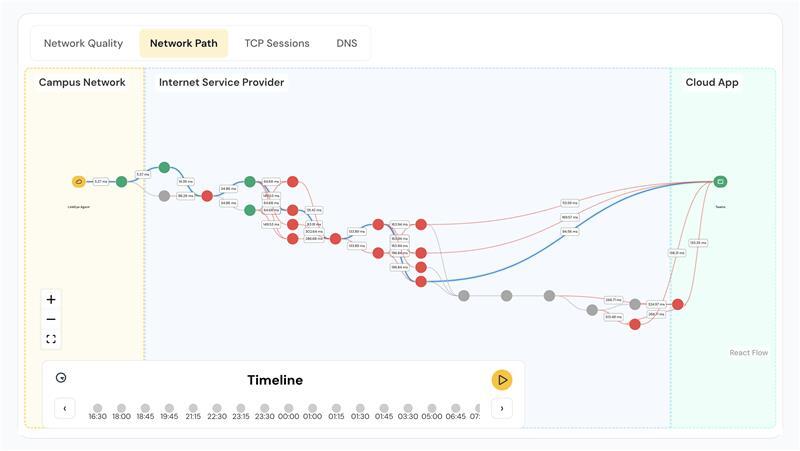Introduction:
Network monitoring is a vital part of network management strategy that provides valuable insights which might affect the organization networking system.
Open-source tools offer enhanced visibility and customization opportunities for organizations that prioritize flexibility over a pre-packaged solution. By adopting to open-source software, organizations empower developers to access and modify the underlying code according to their specific requirements.
Following are some popular open source packages for network monitoring.
Zabbix
Zabbix is a respected open-source network monitoring tool known for its robustness and adaptability. It effectively gathers SNMP and IPMI data using uncomplicated agents, providing in-depth insights into various networks, applications, hosts, and cloud services. Noteworthy is its automatic discovery feature, effortlessly recognizing new devices and changes in monitored assets.
Key Features:
- encompass SNMP-based monitoring
- automatic discovery
- templates designed for seamless product integrations
- robust user community support
Zabbix’s versatility makes it suitable for businesses of all sizes, although it particularly appeals to small businesses. The tool excels in monitoring server performance and extends its network monitoring capabilities to cloud platforms over the internet, with a straightforward setup facilitated by auto-discovery.
Pros:
- It is an open-source and transparent tool.
- It utilizes both SNMP and ICMP, extending its monitoring capabilities.
- It can promptly identify new devices and configuration alterations.
- Provides convenient templates for rapid insights.
- Features a strong notification system that supports SMS, email, custom scripts, and webhooks.
Cons:
- Becoming proficient with the platform requires a substantial time commitment in the long run.
Icinga
Icinga stands as an open-source platform encompassing various tools, including a robust network monitoring solution. These tools are thoughtfully designed to seamlessly integrate, enabling organizations to attain comprehensive visibility into their infrastructure, networks, and metrics through the Icinga stack.
Key Features:
- compatibility with Nagios plug-ins
- monitoring capabilities for networks, servers, and applications
- a supportive user community
- also offers cloud monitoring functionalities
Icinga, born from Nagios Core, stands out by offering advanced network monitoring capabilities while maintaining full free usage. Its extensibility with Nagios plugins makes it adaptable for various monitoring requirements. With regular updates and support for agentless monitoring, Icinga has earned trust as a dependable open-source network monitoring tool, used by notable brands like Adobe, T-Mobile, and Siemens.
Pros:
- Impressive API and well-documented features.
- Offers configurability through both a graphical user interface (GUI) and a domain-specific language (DSL), appealing to administrators who prefer command-line interface (CLI) tools.
- Incorporates built-in visual reporting capabilities.
- Utilizes modules for diverse functionalities, maintaining a streamlined and lightweight core installation.
- Compatible with both Linux and Windows operating systems.
Cons:
- Features a steeper learning curve compared to alternative tools.
- Geared towards technically inclined users, making implementation challenging for those lacking technical expertise.
Prometheus
Prometheus provides a robust network monitoring solution with detailed visualization, ideal for reporting and real-time metrics in network operation centers. It excels with PromQL for data retrieval and visualization, suiting users familiar with query languages.
Key features:
- seamless integration with the Grafana frontend
- flexibility in configuration
- customizable alerting capabilities
- community support
Prometheus is a versatile analysis tool for handling diverse time-series data. While it offers extensive customization, configuring it as a network monitor can be labor-intensive. Many users opt to complement Prometheus with Grafana to fully leverage its features.
Pros:
- Beautiful data visualization with Grafana support
- Powerful query language, efficient resource usage, and no external dependencies
Cons:
- Complex for newcomers, demanding high knowledge
- Limited data pull methods (e.g., S3 integration lacking)
- Initial setup can be time-consuming.
Nagios Core
Nagios offers a comprehensive suite of open-source tools encompassing networking, infrastructure, and application monitoring. While the platform’s foundation, Nagios Core, is open source and free to use, Nagios also provides enterprise-level offerings like Nagios XI, which deliver advanced features, extensive support, and a plethora of pre-built dashboards and alerts.
Key Features:
- availability of Nagios Core as a free and open-source monitoring solution
- its extensibility through plugins
- its status as a leading open-source network monitoring tool
You can extend functionalities like graphing and reporting with a package of 50 core plugins that are easy to download. For more features and integrations, check out the Nagios Exchange, a hub for community-created add-ons. Nagios has a thriving community of over 250,000 members, ranking it among the largest open-source communities worldwide.
Pros:
- Various support options, including free onboarding help
- Lightning-fast alerts and real-time insights
- Versatile monitoring capabilities with standard SNMP protocol
Cons:
- Native graphics for metrics/reporting should be updated
- UI improvements needed, particularly for report creation
- More native support for basic features, as many are currently listed as plugins
- High customizability can be overwhelming at times.
Cacti
Cacti is a versatile monitoring tool known for its exceptional networking graphing and data visualization. It’s detailed like Prometheus, but requires an experienced admin. Ideal for monitoring networks and devices with SNMP, ICMP, and TCP/UDP checks, it also simplifies automatic discovery for busy networks.
Key Features:
· SNMP monitoring
· extensive customizability
· supportive user community
Cacti is a flexible network monitoring tool that requires significant setup. It supports customization through templates and plugins, and it’s compatible with Windows, Linux, and Unix systems.
Pros:
- Extensive customization possibilities
- Multithreaded data collection for monitoring numerous devices
- Detailed graphing and data visualization options
Cons:
- Considerable complexity
- Desire for additional community platforms for user interaction





